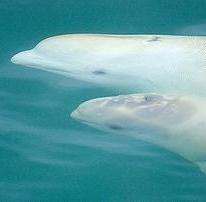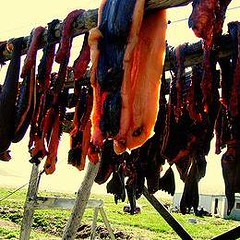 在地極之處,工業活動正逼近珍稀海洋哺乳動物與海鳥的最後避難所。由於北極暖化,航運、漁業以及石油與天然氣的開採正逼近原本終年冰封,過去難以抵達的區域。
在地極之處,工業活動正逼近珍稀海洋哺乳動物與海鳥的最後避難所。由於北極暖化,航運、漁業以及石油與天然氣的開採正逼近原本終年冰封,過去難以抵達的區域。
由科學家與原住民共同發表的一份新報告,指出了北極海13個獨特且脆弱的地區,確認這些地區受到氣候變遷的持續壓力、海冰的喪失以及海洋酸化等威脅,而亟待保護。
報告的共同作者,IUCN全球海洋與極地計畫副執行長托馬斯勞克林(Thomas Laughlin)說:「擴張北極地區經濟活動的利益正在增加」。
他說:「我們現有的資訊與地圖,能讓政府與國際社會對北極地區的保育以及自然資源利用做出正確的決定。」
白令海峽,楚科奇波弗特海岸,巴倫支海沿岸和西伯利亞地區的冰間湖是最脆弱的地方。冰間湖指的是被海冰所包圍的開放水域。
這13個需要保護的地區,是由34位科學家以及北極國家原住民社區的代表,在去年11月的斯克里普斯海洋學研究所的研討會中所提出。
選擇的標準包括:對瀕危物種的獨特性與生活史重要性;脆弱且復原緩慢的地區;生產力高的地區;高生物多樣性地區;以及自然的地區。生活或文化遺產重要地區也在考慮的標準內。
報告中所提到的13個高優先地區有:
 美國聖羅倫斯島:本島以南、白令海阿拉斯加大陸以西的冰間湖,也就是被海冰包圍的開闊水域,每年有六個月是一種海鴨(Spectacled eiders)全球族群的棲息地。冰間湖也提供了海鸚(alcids)、三趾鷗(kittiwakes)、海鷗、過冬的太平洋海象、北極露脊鯨、海豹和北極熊等動物關鍵棲地,也是原住民重要的狩獵區。
美國聖羅倫斯島:本島以南、白令海阿拉斯加大陸以西的冰間湖,也就是被海冰包圍的開闊水域,每年有六個月是一種海鴨(Spectacled eiders)全球族群的棲息地。冰間湖也提供了海鸚(alcids)、三趾鷗(kittiwakes)、海鷗、過冬的太平洋海象、北極露脊鯨、海豹和北極熊等動物關鍵棲地,也是原住民重要的狩獵區。- 美國與俄羅斯間的白令海峽:此區是北極最具生產力以及多樣性的地區。此一狹窄的水域,是太平洋與北極海間唯一的連結,使其成為具有全球意義的熱點。它是許多種鯨魚、海豹和海象繁殖、育幼、攝食以及(或)遷移的關鍵區,這些動物每年兩次由此往返白令海和楚科奇海。
- 美國楚科奇波弗特海岸:這處大陸與浮冰交會之處的海岸被與會人員稱做是「自然的奇蹟」,春季遷徙期間,每天有數百頭露脊鯨通過,夏季與秋季則提供了白鯨、北極熊、海象以及灰鯨遷徙的路徑。本區對沿岸居民也具有相當的古代人類歷史與持久文化遺產意義。附近村莊每年的露脊鯨狩獵季是具有顯著的社會文化意義的活動。
- 俄羅斯的弗蘭格爾島(Wrangel Island):該島週遭的冰間湖是北極熊春季與夏季重要的覓食棲地,也是太平洋海象遷徙以及覓食棲地,同時也是許多海鳥群聚繁殖與攝食的地區。
- 加拿大波弗特海岸(Beaufort Coast)和巴瑟斯特岬(Cape Bathurst):本區具有高度生產力,包含的大型且持續性的冰間湖與浮冰。此地對超過90%的西部北極露脊鯨族群而言,是春季與夏季關鍵的覓食區。超過40000頭白鯨春季與夏季期間在這裡生產與覓食。多種海鳥在此聚集,其中包括北美北極海沿岸唯一的厚嘴海鷗(thick-billed murre)群聚。
- 加拿大的極地浮冰:長年的海冰並不是靜態,而是多變的地理環境,是北極許多動物的關鍵棲地。預測顯示,長年的極地浮冰將會迅速的消失,由比較年輕與季節性的海冰所取代。所剩最長的一段長年海冰位在加拿大群島西北方。而殘存的浮冰很可能是許多依賴海冰動物的唯一避難所,包含了環斑海豹與北極熊。
 蘭開斯特灣(Lancaster Sound)與北方水域冰間湖(North Water Polynya):經常性的北方水域冰間湖是北半球最大且最具生產力的冰間湖之一。此一開放水域是多種鯨魚以及海鳥春季與夏季的重要攝食地。此地常年有海象以及數個北極熊族群,總數約有4000隻。該地區提供了巴芬灣白鯨族群關鍵的渡冬與遷徙棲地,也是大約8000頭北方巴芬灣獨角鯨夏季的棲地。春天的時候,這裡可能聚集了全球的獨角鯨族群。
蘭開斯特灣(Lancaster Sound)與北方水域冰間湖(North Water Polynya):經常性的北方水域冰間湖是北半球最大且最具生產力的冰間湖之一。此一開放水域是多種鯨魚以及海鳥春季與夏季的重要攝食地。此地常年有海象以及數個北極熊族群,總數約有4000隻。該地區提供了巴芬灣白鯨族群關鍵的渡冬與遷徙棲地,也是大約8000頭北方巴芬灣獨角鯨夏季的棲地。春天的時候,這裡可能聚集了全球的獨角鯨族群。- 加拿大與格陵蘭外海的迪斯科灣(Disko Bay)、賀勒費司克邦克(Store Hellefiskebanke):此地是多種名列IUCN紅皮書物種的重要渡冬棲地,包括北極露脊鯨和白鯨和獨角鯨。髯海豹出現在賀勒費司克邦克的海冰上,冬季還有海象與海豹活動,使該地區成為重要的狩獵區。
- 俄羅斯的白海、巴倫支海沿岸:此處高生產力的海岸洋流受到來自北大西洋洋流分支的溫暖海水滋潤,孕育了白海當地白鯨族群,也支持了整個東岸南下浮冰(East Ice)豎琴海豹族群以及大西洋鮭魚和海鳥群聚。
- 俄羅斯的伯朝拉海(Pechora Sea)、卡拉門(Kara Gate):白魚(White fish)在此有極高的多樣性以及豐富度,包含大型的大西洋鮭魚、北極紅點鮭、一種小型的鱈魚(navaga),亦發現有太平洋鯡魚的區域孑遺種,這裡也是北極鱈魚的重要產卵地。本區是多種野鳥的重要棲地,包含當地繁殖種類以及來自西伯利亞中部的遷徙種。這裡也是遷徙的白鯨與大西洋海象棲地。
- 俄羅斯新地群島:新地群島西部週遭海域形成了一個具高度生產力的地區,支持了北大西洋最大的鳥類群聚。本地區由巴倫支海、北極海和喀拉海所圍繞,在1954年至1990年間,被當作核子彈試爆地點,共經歷過224次試爆。
- 俄羅斯與挪威北極領地最北端群島的高緯度北極海島與陸棚:這是瀕危北極露脊鯨斯匹次卑爾(Spitsbergen)族群、大西洋海牛複合種群東大西洋族群以及全球多數受威脅象牙海鷗族群的重要棲地。
- 挪威與俄羅斯外海的西伯利亞冰間湖:這是最穩定且具生態重要性的冰間湖之一,影響著北極海冰的形成以及拉普捷夫(Laptev)與東西伯利亞海的溫鹽循環。西伯利亞冰間湖每年的發展狀況,影響著高緯度北極生態系關鍵中的餌料物種-北極鱈的產卵與生長率。
這13個區域是由科學家與法律專家所召開的兩次會議所決定,IUCN與NRDC(自然資源保護委員會)藉此實行他們以生態系統為基礎的北極海洋環境管理計畫。
聯合國公約海洋法以及其他國際協定和國家法律與法規,提供了一般的法律基礎。
儘管如此,研討會的與會者同意,有必要設立新的規定來保護北極海洋環境。
At the top of the world, industrial activities are closing in on the last refuges of rare marine mammals and seabirds. As the Arctic warms, shipping and fishing as well as oil and gas exploration are expanding into ocean places that once were inaccessible, frozen under year-round ice.
In a new report by scientists and indigenous peoples, 13 unique and fragile areas in the Arctic Ocean are identified for protection against these emerging threats as well as the continual stressors of climate change, loss of sea ice and ocean acidification.
"There is increasing interest in expanded economic activities in the Arctic," said co-author Thomas Laughlin, deputy head of the Global Marine and Polar Program of the International Union for the Conservation of Nature.
"The information and maps we have available now will allow governments and the international community to make the right choices regarding the conservation and use of the natural resources of the Arctic," he said.
The Bering Strait, the Chukchi Beaufort Coast, the Barents Sea coast and the Great Siberian Polynya are among the most vulnerable places. Polynyas are areas of open water surrounded by sea ice.
The 13 areas in need of protection were identified by 34 scientists and representatives of indigenous communities in Arctic countries who gathered at a Scripps Institution of Oceanography workshop last November.
The criteria are: uniqueness, life history importance, importance to endangered and threatened species; vulnerable, fragile and slow recovery areas; areas of high productivity; areas of high diversity; and naturalness. Importance of an area for subsistence or cultural heritage was also considered.
The 13 top priority areas featured in the report are:
St. Lawrence Island, United States: The polynyas, or areas of open water surrounded by sea ice, south of St. Lawrence Island, west of mainland Alaska in the Bering Sea, support nearly the total world population of Spectacled eiders for six months of each year. The polynyas provide key habitat for alcids, kittiwakes, shearwaters, overwintering Pacific walrus, bowhead whales, ice seals and polar bears, and are an important indigenous peoples' subsistence hunting area.
The Bering Strait, United States and Russia: This area exhibits the highest levels of productivity and diversity in the Arctic. This narrow strait is the only connection between the Pacific and Arctic Oceans, making it a hotspot of global significance. It is a key breeding, pupping, feeding, and/or migratory habitat for many species of whales, seals and walrus, all of which pass through the Bering Strait twice a year when migrating between the Bering and Chukchi Seas.
Chukchi Beaufort Coast of the United States: The lead system at the transition between landfast and drifting ice was described by workshop participants as "a wonder of nature," providing a spring migratory pathway for hundreds of bowhead whales daily, as well as beluga whales, polar bears, Pacific walrus and gray whales during summer and autumn.
This region also has an ancient human history and enduring cultural heritage to coastal residents. The annual bowhead whale hunt in villages in the region is a subsistence activity of large sociocultural significance.
Wrangel Island, Russia: The polynyas, leads and coastal waters around Wrangel Island provide important spring and summer feeding habitat for polar bears, migratory and feeding habitat for Pacific walrus, and breeding and feeding for extensive seabird colonies.
Beaufort Coast and Cape Bathurst, Canada: This is a highly productive area, including a large, recurring polynya and lead system. It is vital spring and summer foraging habitat for more than 90 percent Western Arctic bowhead whale population. More than 40,000 beluga whales use this area for foraging and calving in spring and summer. Seabirds of many species congregate here, and it encompasses the only thick-billed murre colony along the Arctic Ocean coast of North America.
Polar Pack Refugium, Canada: The extent of the multi-year ice not a static geographic area but is variable, providing critical habitat for many Arctic creatures. Future projections suggest that the multi-year polar pack ice will continue to rapidly disappear and be replaced by younger and more seasonal ice. The longest remaining portions will be along the northwestern Canadian Archipelago. The remnant pack ice will likely be the only refuge for many ice-dependent animals such as ringed seals and polar bears.
Lancaster Sound/North Water Polynya: The recurring North Water polynya is one of the largest and most productive in the Northern Hemisphere. This open water provides vital spring and summer feeding areas for several whale species and many marine birds. There are year-round concentrations of walrus and about 4,000 polar bears in several populations.
The area provides critical wintering and migratory habitat for the Baffin Bay beluga population and summering areas for a portion of the North Baffin narwhal population, some 80,000 individuals. In spring, it may support most of the world's narwhal population.
Disko Bay/Store Hellefiskebanke, off Canada and Greenland: The area serves as a key wintering area for species on the IUCN Red List of Threatened species, including bowhead and beluga whales and narwhal. Bearded seals are on the ice at Store Hellefiskebanke and walrus and seals appear in winter, making the area an important hunting area.
White Sea/Barents Sea Coast, Russia: These highly productive coastal waters enjoy a coastal branch of warm current originating from the North-Atlantic current. It supports local populations of White Sea beluga whales and provides pupping and molting areas for the entire East Ice harp seal population, and supports Atlantic salmon as well as seabird colonies.
Pechora Sea/Kara Gate, Russia: Here a high diversity and abundance of white fishes, a large breeding stock of Atlantic salmon, as well as Arctic char, navaga, and local relict races of Pacific herring are found, and is an important spawning ground for polar cod. The region contains important areas for wildfowl, both locally breeding and migrating from western and central Siberia. It supports migrating beluga whales and Atlantic walrus.
Novaya Zemlya, Russia: The western waters around Novaya Zemlya constitute a highly productive marine area that supports the largest seabird colonies in the Northeast Atlantic. Surrounded by the Barents Sea, the Arctic Ocean and the Kara Sea, Novaya Zemlya was used as a nuclear test site from 1954 to 1990. It hosted 224 nuclear detonations during that period.
High Arctic Islands and Shelf, the northern-most archipelago in the Russian and Norwegian Arctic: This is a key area for the endangered Spitsbergen population of bowhead whale, the northern stock of the East-Atlantic meta-population of Atlantic walrus, and most of the world's breeding population of the threatened ivory gull.
Great Siberian Polynya, off Norway and Russia: One of the most stable and ecologically important polynyas, it influences ice production in the Arctic Ocean and affects thermo-haline circulation in much of the Laptev and East-Siberian Seas. Annual development of the Great Siberian polynya influences spawning and growth rates of polar cod, the key prey species of the High Arctic ecosystem.
These 13 areas were identified by scientists and legal experts convened in two workshops by the IUCN and NRDC as part of their project to implement ecosystem-based management in the Arctic marine environment.
The United Nations Convention on the Law of the Sea, together with other international agreements and national laws and regulations, provides a general legal foundation.
Still, workshop participants agreed, new rules may be necessary to protect the Arctic marine environment.
全文及圖片詳見:ENS報導








